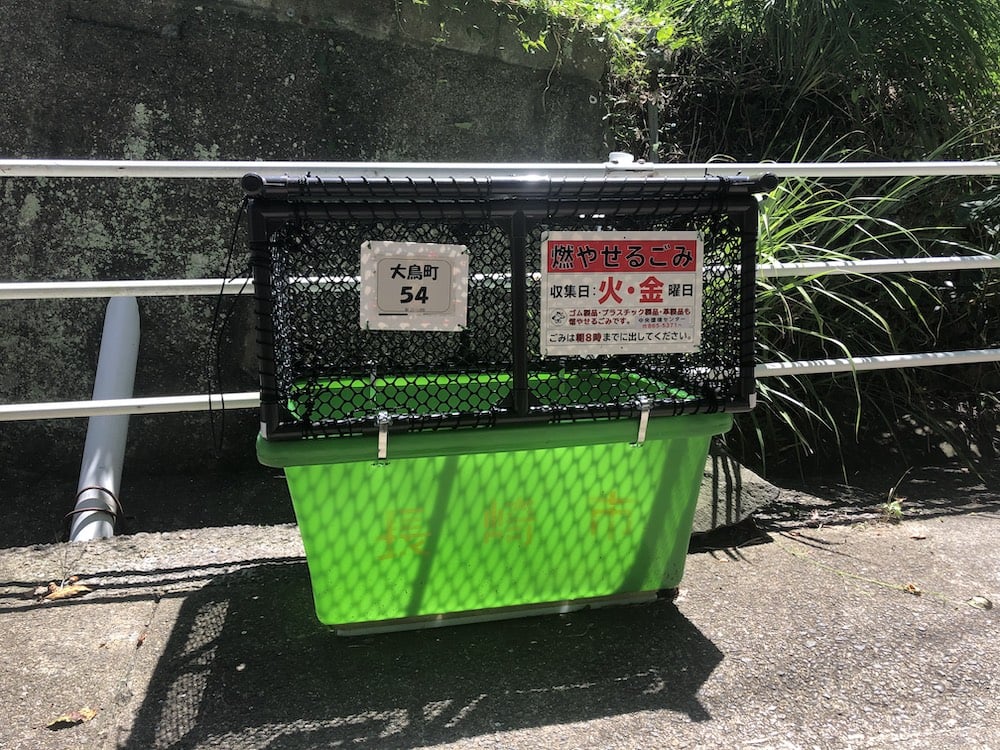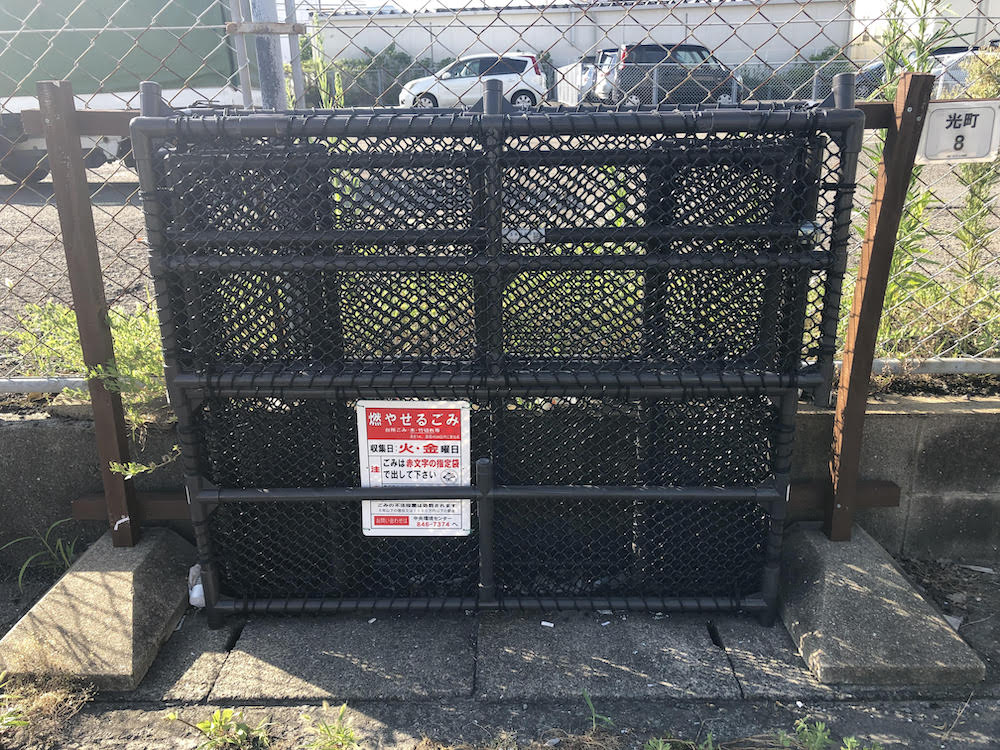
You’ve probably heard the rumours that sorting rubbish in the land of the rising sun is a devilishly difficult task! I’m going to give you the low down on how things work here in my home of Nagasaki specifically. However, lots of these observations and rules apply for the whole of Japan. Let’s get stuck in!
義理
In England, where I’m from, household waste disposal came in the form of 2 huge bins outside my house: one for recyclables, one for everything else. A rubbish van comes along and whisks all of it away for us, so we don’t have to deal with it anymore.
But here in Japan, everything is different. More specifically, Japanese people are built differently. The inbuilt sense of social obligation, 義理, drives everything here. In England, we’d rather hire someone to sort our rubbish for us, and if asked to do so ourselves we’ll cry out, “That’s not my job!”. But here in Japan, the citizens happily become the workers out of giri. Everything from sorting rubbish at home to cleaning the collection stations, in Japan the citizens run it all.
長崎市
Writing this kind of article has to come with the caveat that rubbish collection is different in every area of Japan. I’m going to go into detail about my situation in Nagasaki city, and what it’s like being a foreigner trying to navigate it. Just don’t sue me if this isn’t your experience, okay? I will say though, I’ve extensively travelled the length of Japan, and there are only minor changes to the Nagasaki system.
I have 4 different kinds of bins that I have to sort rubbish into at home. That’s right, 4! They consist of:
- プラスチック (plastics)
- 資源 (recyclables: PET bottles, cans, etc)
- 燃やせない (non-burnables: electrical appliances, big bits of metal, etc)
- 燃やせる (burnables: everything that doesn’t fit in one of the above categories)
You can buy bags for these different kinds of rubbish from loads of stores in the city. Everywhere from convenience stores to 100-yen stores to supermarkets stock them. They’re normally pretty cheap, so I don’t mind buying them at all. But, for a clutter-brain like me, I’ll often find myself running out of one type of bag that I need.
I live in a mansion that doesn’t have a designated in-building collection point. Instead, I have a burnable collection point a 2-minute walk from my house, and all the rest is about a 5-minute walk away. I’ll be honest, I hate trying to get my recyclables, plastics, and non-burnable out in time for collection in the morning. The 5-minute walk to the point is a slight bit too long for my liking, especially when I’m rushing and late to work.
In Nagasaki, the collection points are in the form of collapsible wire cages that you throw the bags straight in. You can throw the bags in these cages from the night before the collection day, but anything before that and you’re liable to be looked at as being a bit 邪魔 (annoyingly in the way). Interestingly, in Nagasaki there are so many hills that many of the rubbish collection boxes are on sledges that get pulled down by the binmen.

My burnables and cardboard get picked up on Tuesdays and Fridays, and all others get collected just on Fridays. The world’s most punctual bin-men come reliably at 8:00am on these days. I’ve had it before where I’ve run downstairs to throw a stinky bag of rubbish away before work, and seen the men drive off at 8:01. Absolutely brutal. Especially as the next collection day is too far off to just leave it there, so the only choice is to take it all the way back up to my 4th floor apartment and leave it there to fester until the next collection date.
How to Sort Rubbish
Let’s start with plastic. You probably don’t need to be told this to know, but Japan is in a secret affair with plastic. For a country so keen to push Sustainable Development Goals (SDGs), they use an astronomical amount of unnecessary plastic. Everything from cookies to bananas are often individually wrapped. As you can imagine, living in Japan your plastic bin will fill up faster than any other. The rules around how you sort plastic is pretty simple, just make sure it’s clean when it goes in. If you have a bento box, for example, you’d better give it a rinse before it goes in the bag.
Next is recyclables. The same rules of cleanliness apply here. Something that might surprise you is that in Nagasaki you are required to put the caps and labels from PET bottles in plastics, and then the bottle itself in recyclables. Also, things like PET bottles that had oily dressings in, soy sauce, and the the like, are actually put in burnable rather than recyclables.
Next we have the non-burnables. To be honest, I don’t often throw anything away in there. But it includes things like electronics or bulky things like ironing boards. This one is a bit random but it is what it is.
Finally, we come to burnables. This is your standard rubbish bin really. This is where you’ll put your food waste and anything that can’t be filtered into the other one. A super-senpai tip is that if you have decent freezer space, I’d store my food waste in the freezer until you’re ready to throw it out in summer. Japan is brutally hot and humid in summer and sometimes a horrible stench can develop if you have food waste left in the heat.
Cardboard has to be bundles and tied with some string and put out on the same day as the burnable rubbish. I don’t know why, but I find dealing with cardboard the most annoying of all rubbish-related things here. Something about having to make sure it’s bundled neatly just does my nut in. I’m sure it’s not a big deal for other people though.

Tips and Random Things
Now let’s have a little look at things that I was surprised by when I first came.
First up is that bulky items need to be paid to be removed. The Nagasaki website lists things such as fridges and TVs as bulky. You need to go to a post office or bank to buy a sticker that gets put on the item when it’s left outside for collection. For things up to 1m long and under 30kg you’ll pay 523 yen. For over that, you’ll be paying 1047 yen. This means it might be worth looking into selling, or giving away, things that are bulky rather than losing out to this fee a load.
Second, is oil hardener. This stuff is really cool. Japan loves it’s tempura and fried chicken, so it’s no surprise that you can get a little powder (固めるテンプル Katameru Tempuru) to put into a pan full of oil that solidifies it and means you can put it in burnable garbage easily. Useful stuff.
Another thing that I saw, that surprised me, was that laptops and computers are supposed to go back to the manufacturer for disposal when they’re at the end of their life. I’ve never thrown out a computer to be honest, but it surprised me that laptops wouldn’t go in non-burnable garbage.
Japan has quite the reputation for being super anal about it’s rubbish. But becoming that little bit more contentious about your waste and doing things the Japanese way really isn’t the pain that some people think it is. Why not get stuck in an impress your neighbours with how well you can sort your plastics from your burnables.

















